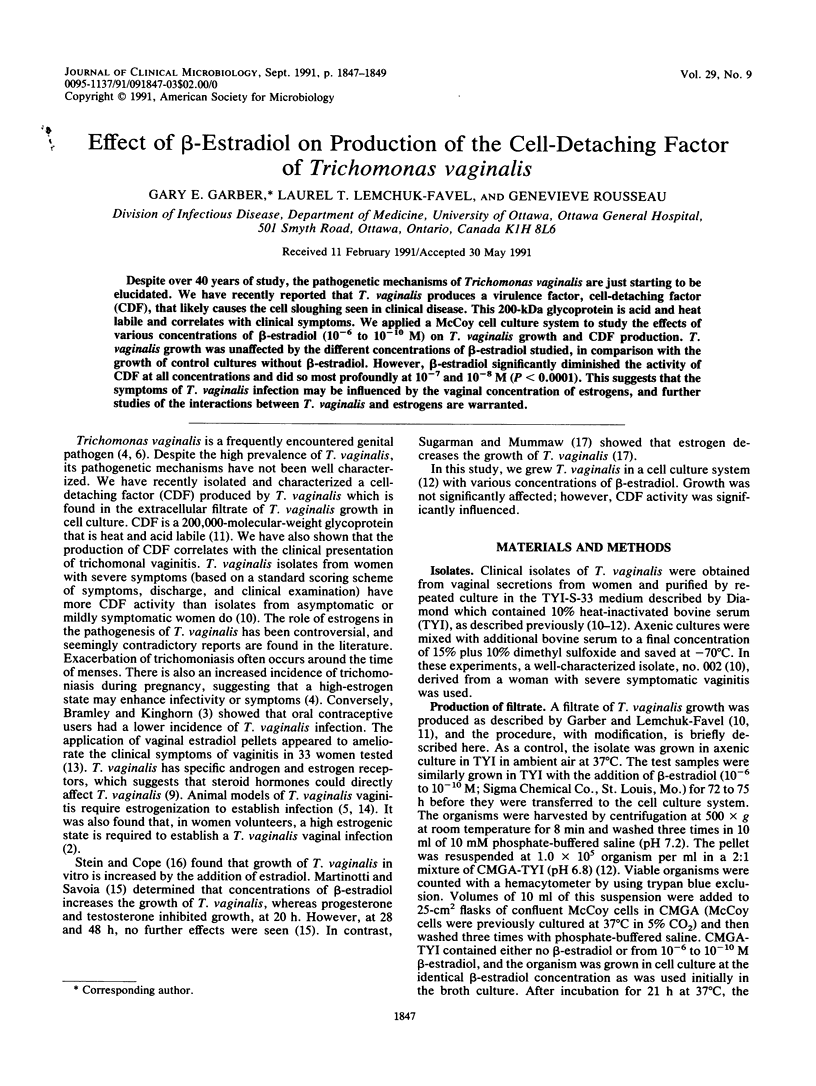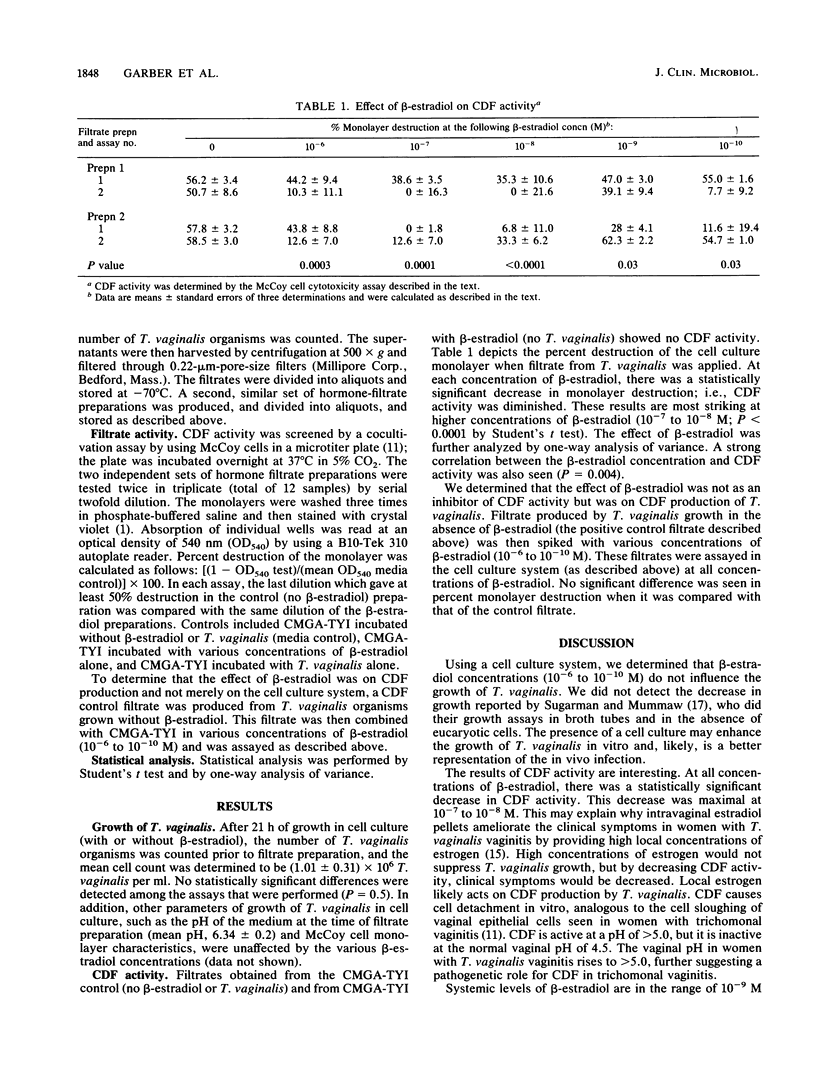Abstract
Despite over 40 years of study, the pathogenetic mechanisms of Trichomonas vaginalis are just starting to be elucidated. We have recently reported that T. vaginalis produces a virulence factor, cell-detaching factor (CDF), that likely causes the cell sloughing seen in clinical disease. This 200-kDa glycoprotein is acid and heat labile and correlates with clinical symptoms. We applied a McCoy cell culture system to study the effects of various concentrations of beta-estradiol (10(-6) to 10(-10) M) on T. vaginalis growth and CDF production. T. vaginalis growth was unaffected by the different concentrations of beta-estradiol studied, in comparison with the growth of control cultures without beta-estradiol. However, beta-estradiol significantly diminished the activity of CDF at all concentrations and did so most profoundly at 10(-7) and 10(-8) M (P less than 0.0001). This suggests that the symptoms of T. vaginalis infection may be influenced by the vaginal concentration of estrogens, and further studies of the interactions between T. vaginalis and estrogens are warranted.
Full text
PDF


Selected References
These references are in PubMed. This may not be the complete list of references from this article.
- Alderete J. F., Pearlman E. Pathogenic Trichomonas vaginalis cytotoxicity to cell culture monolayers. Br J Vener Dis. 1984 Apr;60(2):99–105. doi: 10.1136/sti.60.2.99. [DOI] [PMC free article] [PubMed] [Google Scholar]
- Azuma T. A study on the parasiting condition of trichomonas vaginalis with special reference to the relationship between estrogen and the growth of trichomonas vaginalis. J Jpn Obstet Gynecol Soc. 1968 Jul;15(3):168–172. [PubMed] [Google Scholar]
- Bramley M., Kinghorn G. Do oral contraceptives inhibit Trichomonas vaginalis? Sex Transm Dis. 1979 Oct-Dec;6(4):261–263. doi: 10.1097/00007435-197910000-00009. [DOI] [PubMed] [Google Scholar]
- Brown M. T. Trichomoniasis. Practitioner. 1972 Nov;209(253):639–644. [PubMed] [Google Scholar]
- Cappuccinelli P., Lattes C., Cagliani I., Negro Ponzi A. Features of intravaginal Trichomonas vaginalis infection in the mouse and the effect of oestrogen treatment and immunodepression. G Batteriol Virol Immunol. 1974 Jan-Jun;67(1-6):31–40. [PubMed] [Google Scholar]
- Catterall R. D. Trichomonal infections of the genital tract. Med Clin North Am. 1972 Sep;56(5):1203–1209. doi: 10.1016/s0025-7125(16)32345-8. [DOI] [PubMed] [Google Scholar]
- Collins W. P., Branch C. M., Collins P. O., Sallam H. N. Biochemical indices of the fertile period in women. Int J Fertil. 1981;26(3):196–202. [PubMed] [Google Scholar]
- DIAMOND L. S. The establishment of various trichomonads of animals and man in axenic cultures. J Parasitol. 1957 Aug;43(4):488–490. [PubMed] [Google Scholar]
- Ford L. C., Hammill H. A., DeLange R. J., Bruckner D. A., Suzuki-Chavez F., Mickus K. L., Lebherz T. B. Determination of estrogen and androgen receptors in Trichomonas vaginalis and the effects of antihormones. Am J Obstet Gynecol. 1987 May;156(5):1119–1121. doi: 10.1016/0002-9378(87)90122-0. [DOI] [PubMed] [Google Scholar]
- Garber G. E., Lemchuk-Favel L. T. Association of production of cell-detaching factor with the clinical presentation of Trichomonas vaginalis. J Clin Microbiol. 1990 Nov;28(11):2415–2417. doi: 10.1128/jcm.28.11.2415-2417.1990. [DOI] [PMC free article] [PubMed] [Google Scholar]
- Garber G. E., Lemchuk-Favel L. T., Bowie W. R. Isolation of a cell-detaching factor of Trichomonas vaginalis. J Clin Microbiol. 1989 Jul;27(7):1548–1553. doi: 10.1128/jcm.27.7.1548-1553.1989. [DOI] [PMC free article] [PubMed] [Google Scholar]
- Garber G. E., Sibau L., Ma R., Proctor E. M., Shaw C. E., Bowie W. R. Cell culture compared with broth for detection of Trichomonas vaginalis. J Clin Microbiol. 1987 Jul;25(7):1275–1279. doi: 10.1128/jcm.25.7.1275-1279.1987. [DOI] [PMC free article] [PubMed] [Google Scholar]
- Lirosi G., Guarascio A. Effetti delle modificazioni ormonali dell'ambiente vaginale nella terapia delle vaginiti specie da Trichomonas. Minerva Ginecol. 1972 Jan 15;24(1):23–27. [PubMed] [Google Scholar]
- Maestrone G., Semar R. Experimental intravaginal infection with trichomonas foetus in guinea pigs. Chemotherapy. 1967;12(3):137–145. doi: 10.1159/000220496. [DOI] [PubMed] [Google Scholar]
- Martinotti M. G., Savoia D. Influenza di alcuni ormoni steroidei sulla crescita di Trichomonas vaginalis. G Batteriol Virol Immunol. 1985 Jan-Jun;78(1-6):52–59. [PubMed] [Google Scholar]
- Sugarman B., Mummaw N. The effect of hormones on Trichomonas vaginalis. J Gen Microbiol. 1988 Jun;134(6):1623–1628. doi: 10.1099/00221287-134-6-1623. [DOI] [PubMed] [Google Scholar]


